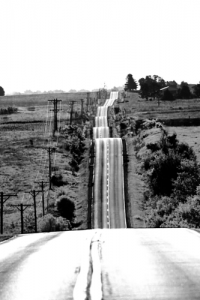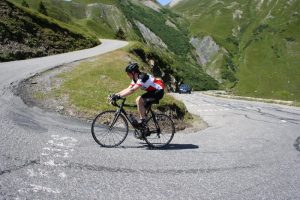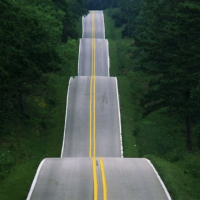I created the first version of this profile as a workshop at the 2002 WSSC (World Spinning and Sports Conference). Prior to that session, no one had taught Spinning® (or any indoor cycling) instructors how to simulate the up-and-down variations in terrain in an indoor cycling class—at least not officially or at a conference or workshop. (You can download my handout for that workshop here.)
While I’ve posted songs on ICA that are good for rolling hills or switchbacks (three of which are used in this profile), and wrote two Obsessed with Cycling Drills posts on this very topic (switchbacks here and rolling hills here), I’ve been hesitant to create this ride as a full profile on ICA because there are so many changes that it’s a challenge to write it out in a way that makes sense to other instructors, and this particular profile has a lot of changes.
However, I thought it was time to write this profile out for you because it is such a fun one, both to teach and to take…but fair warning, it will take some work and practice on your part! I recommend that you sit down and listen to the songs while you preview this profile and see how I interpret each song and its energy breaks. You may decide to make changes in the timing (if so, write them out on index cards). And then, practice riding the profile at least once or twice before trying to teach it to your own class. You may decide to change up the timing, or perhaps you like what I’ve done and want to do it exactly like I did—I’d love to hear about that if you do! Also, I filmed this profile as a virtual ride so you can see how I coach it; it’s available in the ICA Ride with Jennifer archives.
Let me explain what I listen for in the songs to determine the ups and downs of rolling hills and how I write it out in the profile.
Rolling Hills
Trance songs are great for rolling hills because they often have a buildup of energy until they reach a crescendo, then the music breaks and seems to go faster (in reality, the tempo is usually the same). For example, listen to the song “Nightmare.” I describe two climbs in which the energy builds over 1 to 1.5 minutes. When I hear music build like this, I see a rising hill that gets steeper. As we get closer to the top and the music builds, it inspires me to stand up and push harder to the summit. The TOP is represented by the crescendo in the music. At that point, it’s like the music “releases,” and I describe rolling over the top, reducing resistance, and letting the legs spin faster (~90 rpm) at an easier intensity. You will have to increase cadence ahead of the beat at this point. This serves as a short recovery in between harder pushes.
Then, at the bottom of the descent, you add some more resistance and grab the beat again.
“Salva Mea” is a unique song and is one of my most favorite for this purpose. Not only is it a long song, but it has so many changes in energy that to me, it feels like a long, sinewy climb that is broken up by several short downhills that immediately swoop back uphill. The steepness changes throughout the climb, just like so many real climbs do outdoors. In this song, I use those short downhills as brief recoveries, but then propel myself quickly back up the climb. This song also does something very few songs do; it changes tempo at 3:55. The beat changes from 128 bpm (64 rpm) to 106 bpm, so you add a lot of resistance and pedal very slowly at 53 rpm (normally I wouldn’t ride this slow but it’s not for long; be sure to ask riders to use caution not to add excessive resistance). The beat drops away completely at 6:09 and, in a very dramatic fashion, picks back up to the primary tempo of 128 bpm at 6:42.
When a song takes an energy break and has a symphonic or instrumental segment, or if the beat drops away (these all happen in most of my songs below), I use this as a moment to stand up. Not to attack and push hard, but simply to maintain intensity with a little more resistance out of the saddle.
Switchbacks

A switchback is a tight turn in the road, also known as a hairpin turn. Not every switchback is created equal because road engineers are following the curve of mother nature. Sometimes the road levels out slightly, allowing you to ease up in the switchback; other times they get steeper on the switchback. I usually describe to my riders that the road steepens as we exit the turn so we have to add resistance and stand. So basically, a switchback is nothing more than a reason to stand, but you are using an actual outdoor visual to coach your riders through it. Sometimes I use an energy break in the music to define the switchback; other times I’ll stand on the chorus.
Let me know how you enjoyed this profile below and if you made any changes in the playlist that you’d like to share. I love hearing how ICA members modify our profiles!


Can I just say this is awesome as I took this session with you during that conference!! I still have all my notes, etc from it. My only time I was able to make it down to Miami. BTW..
I miss when there were multiple sites (Chicago!!) I have the CD I burned with the music still as well. Ok, so I may have a problem. If you saw all the ring binders, cassette tapes, CD’s burned and now all my digital files–I think as instructors I am not alone–hehe!!
so nice to hear from someone who attended that session, Celestia! Glad you enjoyed it. I was always bummed that they stopped doing WSSC events outside of Miami as well. It was so great for people in parts of the country who couldn’t travel that far for a conference…it wasn’t an inexpensive trip with flight, airfare, meals, time off, plus the conference fee and the inevitable purchase of one of everything in the WSSC gift shop! 😉
No, you aren’t alone but believe it or not, some instructors still don’t know how or aren’t good at organizing their profiles either in binders or digitally. Hmmm, maybe I should do an article/video just on that!